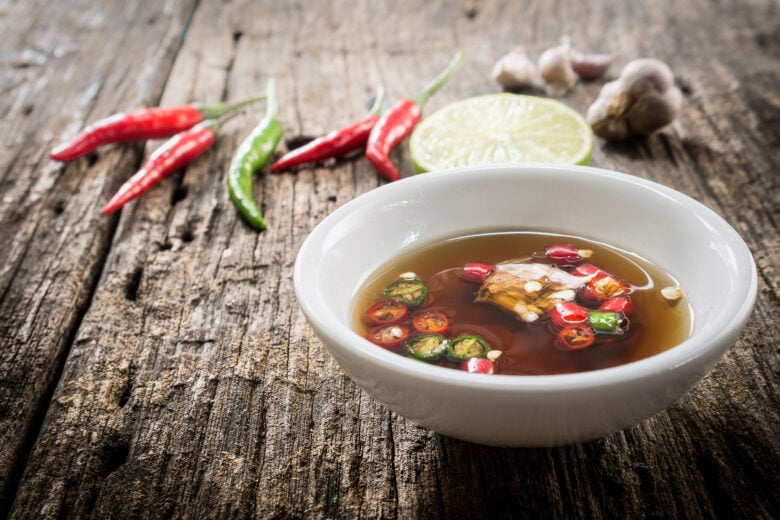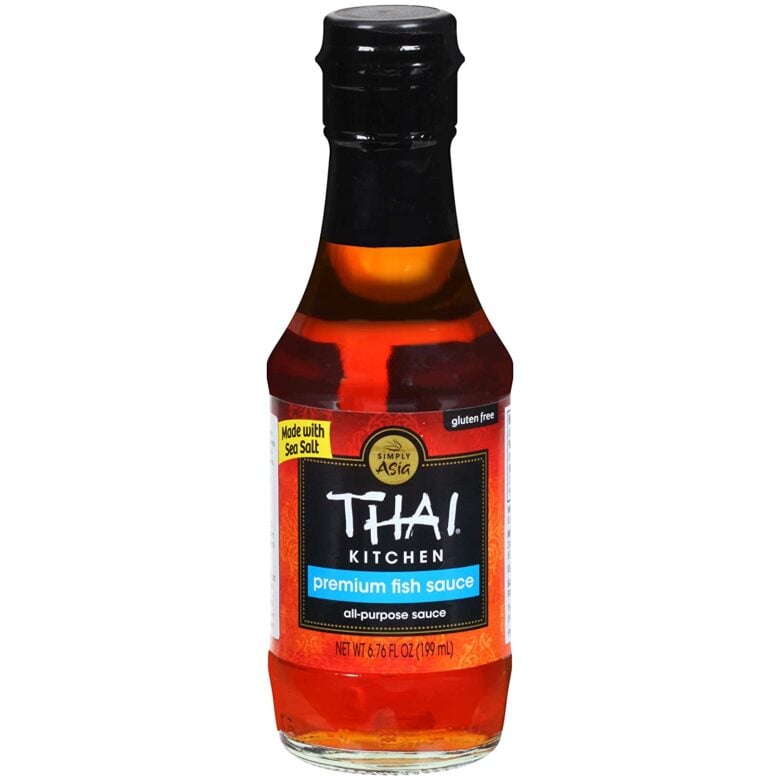Fish Sauce Uses and Substitutes
- By Amy Dong
- Updated Aug. 18, 2025
Fish sauce adds a slightly salty and savory flavor to several different types of Asian cuisine. It’s most often seen in Thai and Vietnamese dishes like curry and pho. If you’re curious, there’s much to discover about fish sauce!

What is Fish Sauce?
Fish sauce is a condiment that originated in Ancient Greece and Rome, where it was called garum. It eventually made its way to Asia and is now used in many different types of Asian-inspired recipes.
If you’re familiar with Thai cooking, you definitely recognize this sauce! It can be used as the base of a marinade, a seasoning in sauces, and even as a condiment.

What is Fish Sauce Made Of?
Fish sauce is traditionally made with just three ingredients: fish, water, and salt. The mixture is fermented to achieve the sauce – sometimes for years at a time! Fish sauce is typically prepared with anchovies, but it can also be made out of mackerel, shrimp, or krill.
In order to make it, the fish of choice is placed in a barrel with water and salt and is then left to ferment. The salt breaks down the fish, and the results are a briny, savory, and slightly fishy liquid appropriately dubbed fish sauce. It’s light golden brown in color and boasts a thin consistency.
What Does Fish Sauce Taste Like?
If you’re afraid of adding fish flavor to your dishes, never fear. Fish sauce does have a strong fish smell, but the taste is a lot milder. Like tamari, oyster, and soy sauces, it has an earthy and umami taste. It’s a unique way to add flavor to various dishes, as long as you don’t go overboard! Use fish sauce sparingly and you can’t go wrong. You really only need a tablespoon or two to achieve the added flavor you’re after.
Many people describe fish sauce taste as “funky,” but in the best way possible! Citrus juices like lemon and lime are often added along with it to balance out the flavor. It also goes great with fresh chiles. In Thailand, you’ll often see small bowls of fish sauce, lime juice, and chiles set out on the table as a dipping sauce.
Oyster Sauce vs Fish Sauce
Because fish sauce and oyster sauce are both made from seafood, the oyster sauce vs. fish sauce question is a common one. Both are briny liquids that are often used as flavor add-ons in dishes like stir fry, curry, soups, and sauces.
The two condiments are, in fact, quite different. Fish sauce is thin, watery, and light brown in color, while oyster sauce is thick, gooey, and dark brown. Fish sauce has a distinct fish smell to it and oyster sauce is much milder. Their tastes are slightly different as well. The taste of oysters is barely noticeable in oyster sauce, whereas fish sauce does taste like fish.
Oyster sauce is almost never used as a table condiment, and as you now know, fish sauce is commonly seen on Thai and Vietnamese tables as a dipping sauce. The oyster sauce vs. fish sauce debate, sorted!

Fish Sauce Uses
Fish sauce is used to create the complex flavor profiles seen in Thai, Vietnamese, Cambodian, and other Asian cuisines. It can be a little bit more difficult to work with compared to soy sauce or tamari, but once you get it right, it can really take your dishes to the next level.
It’s most often used in marinades, stir-fries, and dipping sauces. It also makes a great addition to fried rice. It’s most delicious when paired with other flavor-packed add-ons such as garlic, citrus juice, and spicy chiles. It’s that secret ingredient you never knew you needed!
How to Start Using Fish Sauce
- Fish sauce is a powerful ingredient that adds deep, savory flavor, also known as umami, to a wide variety of dishes.
- For beginners, it’s important to use it sparingly. Start with just a few drops or up to a teaspoon in soups, stir-fries, marinades, or sauces.
- It works especially well in Asian recipes like Pad Thai, pho, or Vietnamese dipping sauce called nuoc cham.
- Fish sauce can also enhance everyday dishes like tomato sauce, chili, or roasted vegetables.
- Think of it as a more complex alternative to salt or Worcestershire sauce.
- To get comfortable using it, try adding it to recipes where bold, rich flavor fits naturally.
- Stir it into salad dressings, pasta sauces, or a glaze for grilled meats. We also love it in our Asian Cucumber Salad.
- Mix it with lime juice, garlic, sugar, and chili to make a quick and flavorful dipping sauce.
- Since it is strong and salty, always start with a small amount and adjust to taste.
- Once you are familiar with it, fish sauce becomes a secret weapon for adding deep, delicious flavor to your cooking.
Fish Sauce Recipes
With all of this talk of fish sauce, you’re probably wondering what types of recipes you can use it in! Here are some excellent options to try at home now:
Curries and Soups
- Red Thai Curry Mussels – Fish sauce deepens the broth with savory umami, balancing the richness of coconut milk and the heat of red curry.
- Thai Green Curry Chicken – It balances the fragrant green curry paste with salt and umami, rounding out the creamy, spicy flavors for this Thai family favorite!
- Red Thai Curry Mussels – It deepens the broth with savory umami, balancing the richness of coconut milk and the heat of red curry.
- Coconut Curry Chicken Noodle Soup – We love how it enhances the broth with layers of savory flavor, complementing the creaminess of the coconut and the warmth of the curry.
Asian Style Salads
- Crunchy Thai Salad – It adds complexity to the dressing, cutting through the crunch with salty, tangy depth that brings the salad to life.
- Vietnamese Style Rice Salad (Gluten-Free, Dairy-Free) – A splash of fish sauce ties everything together with a punch of salty-sweet flavor that enhances herbs and fresh veggies.
Other Asian Favorites
- Thai Chicken and Rice (One Pan Meal Prep) – Fish sauce seasons the dish from within, infusing the chicken and rice with a bold, savory backbone in just one pan.
- One-Pot Asian Pasta – Just a bit of fish sauce boosts the sauce with extra depth, making this fusion-style pasta taste richer and more satisfying.
Best Fish Sauce Alternatives
If you can’t find any fish sauce, are vegetarian, or simply don’t like the idea of adding a fish-based condiment to your meals, you can use a substitute for fish sauce. Below are some preferred fish sauce alternative ideas:
- Worcestershire sauce: Tangy and complex, with anchovies and a hint of sweetness. It’s one of our pantry staples for soups, marinades, and sauces.
- Soy sauce: Savory and salty, though less complex than fish sauce. It works in a pinch for stir-fries, soups, and marinades.
- Tamari sauce: Rich and savory with a smoother, less salty flavor than regular soy sauce. It’s great for stir fries, soups, dipping sauces, and marinades, and it’s naturally gluten-free.
- Oyster sauce: Thicker and slightly sweeter than fish sauce, with a rich umami taste. It’s best for stir-fries and marinades.
- Vegan fish sauce: Made from seaweed, mushrooms, and soy sauce, it ofers similar umami without the fish. It’s great when used as a one-to-one replacement in most recipes.
- Coconut aminos: A soy-free, gluten-free option with mild sweetness and light umami. We love using it for stir-fries, soups, and marinades. Add extra salt if needed.
The Best Fish Sauces
Because fish sauce is so commonly used, you should have no problem finding it at your local supermarket. You can also stock up online. Here are some brands to help you get started:
Commonly Asked Questions
It does. Make sure to pay attention to the expiration date before you use your fish sauce. That said, it does keep well beyond its best-by date – up to one year. Unopened fish sauce will keep for 2-3 years. Opened fish sauce will keep for up to 6 months at room temperature, and up to one year in the fridge.
Traditionally, fish sauce is made with just fish, water, and salt. Nowadays, additional ingredients are sometimes added. Some brands also include molasses, sugar, and rice vinegar for additional flavor. If you want to stick with traditional fish sauce options, make sure to go for brands that only use those three main ingredients.
If you choose to buy your fish sauce in the supermarket, head to the condiment section first. It is usually kept near soy sauce. If you can’t find it there, check out the international specialty foods aisle. If all else fails and you have an Asian supermarket in town, you’ll definitely find it there. If not, scope out the links to popular brands provided above!
No, fish sauce does not need to be refrigerated after opening. You can easily store it in the pantry or cupboard at room temperature.
High-quality fish sauce is usually made with only fish, salt, and water, making it gluten-free but not all brands are. Make sure you check before purchasing if you’re sensitive to gluten.
More To Cook And Eat
- Thai Green Curry Noodles – if you’ve got a craving for soup, this is comfort food at its finest!
- 15-Minute Ginger Soy Asian Steamed Fish – you don’t even need a steamer to recreate this steamed fish recipe!
- Vietnamese Chicken Salad – crunchy, fresh, and topped with a flavorful Asian-inspired homemade dressing.
- Pumpkin Shrimp Bisque – a unique, pumpkin-filled take on a seafood-based soup.
